Why Does Condensation Form On A Drinking Glass?
Pour an ice-cold drink into a glass on a hot summer day and soon, water droplets will form on the outside of the glass. How does this condensation on glass happen and where does the water come from? An understanding of the states and phases of matter answers these questions.
States of Matter
Consider three of the states of matter: solid, liquid and gas.
In a solid, particles are packed close together like building blocks and have a definite shape. The particles of the solid won't move much, but they will have a vibration from the subatomic particles like electrons constantly in motion.
Liquids will conform to the shape of a container — much like an ice cold drink poured into the glass, where the liquid fills the container. In liquids, the particles are loosely packed and can flow around each other.
Gases have no definite shape and will expand to fill a container. There is so much space between gaseous particles that the particles rarely bump into contact with each other.
States of Matter: Phase Changes
Water can move through the three states of matter depending on temperature. It can be found as a solid in ice, liquid water and as a gas in water vapor.
Consider the flow diagram below of how the states of matter phase into each other; the processes by which this happens are named:
Solid → in melting turns to → liquid → in evaporation turns to → gas
The reverse is:
Gas → in condensation turns to → liquid → in freezing turns to → solid
Notice that the condensation process is when a gas turns into a liquid. With water, this means water vapor has turned into liquid water.
A condensation chemistry definition is the process of a substance changing from a gaseous to a liquid state. This process is caused by a change in mostly temperature, but also pressure.
Condensation Process and Energy
Review the flow diagram for gas into a liquid:
Gas → in condensation turns to → liquid
Also recall how the molecules acted in both the gaseous and liquid states. In a gas, particles have a high kinetic energy. In a liquid, they have less kinetic energy. A gas has to lose energy to become a liquid.
The water molecules in the gaseous state lose heat energy, slow down their motion and begin to "stick" together to form a liquid.
Condensation: Water Cycle
Water beads have appeared on the glass, and, from the definition, this means that water vapor has condensed into liquid on the glass surface.
This water vapor is always present in the air, even on clear days. Water is always condensing and evaporating (condensation's opposite) in the air. Grasping the water cycle at the point of condensation may help in recognizing how water forms on a cold glass.
In the water cycle, water vapor pushed into the cooler upper atmosphere slows the evaporation rate down to less than the rate of condensation. Condensation occurs at a quicker rate, and the gaseous water molecules condense around tiny airborne particles of dust, salt and smoke to form tiny droplets that can grow by collecting more liquid water molecules.
Condensation on Glass
Similar to the cooler upper atmosphere, as the glass in our example from the beginning becomes cold from the ice in the drink, it reaches a temperature where condensation happens at a higher rate than evaporation. Even on a hot day, and even though hot air can hold more water vapor than cold air, there is an upper limit to how much water vapor air can hold.
The movement of particles can explain this increase in condensation rate. When the hot air comes in contact with the cold glass, heat is transferred from the hot air to the cold glass. The loss of heat in the surrounding air causes the water vapor by the glass to lose energy. Once energy is lost, the water vapor condenses into liquid on the glass.
Once the ice melts in the drink, the temperature of the liquid inside the glass and the surrounding air will come into equilibrium, and condensation on the glass will no longer be formed.
Cite This Article
MLA
Kozlowski, Rosann. "Why Does Condensation Form On A Drinking Glass?" sciencing.com, https://www.sciencing.com/condensation-form-drinking-glass-6680284/. 26 March 2020.
APA
Kozlowski, Rosann. (2020, March 26). Why Does Condensation Form On A Drinking Glass?. sciencing.com. Retrieved from https://www.sciencing.com/condensation-form-drinking-glass-6680284/
Chicago
Kozlowski, Rosann. Why Does Condensation Form On A Drinking Glass? last modified March 24, 2022. https://www.sciencing.com/condensation-form-drinking-glass-6680284/
